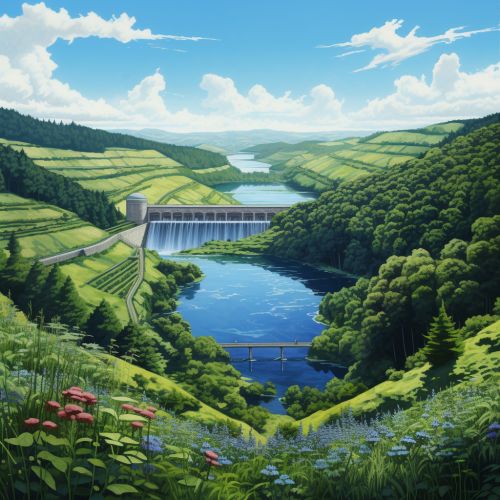Water storage
Overview
Water storage is the practice of capturing and storing water for various uses, including irrigation, drinking, industrial processes, and environmental management. It is a critical component of water management, which involves the control and movement of water resources to minimize damage from water-related disasters and to optimize the beneficial use of water. The practice of water storage dates back to ancient civilizations and continues to be a vital aspect of modern society.
History
The practice of water storage has a long history, dating back to ancient civilizations. The earliest known evidence of water storage comes from the Ancient Near East, where archaeologists have found evidence of large-scale water storage systems dating back to the 3rd millennium BC. These early systems were primarily used for irrigation, with water being stored in large reservoirs and distributed through a network of canals.
In ancient Rome, the Roman aqueduct system was used to transport water from sources outside the city to storage reservoirs within the city. These reservoirs, known as castella, were used to store and distribute water for public and private use. The Roman aqueduct system was a remarkable feat of engineering, and many of its principles are still used in modern water storage and distribution systems.
In the Middle Ages, water storage was primarily used for irrigation and drinking water. Wells and cisterns were common methods of water storage, with water being drawn from these sources as needed. In some areas, water was also stored in large ponds or lakes, which were used for irrigation and as a source of drinking water.
In the modern era, water storage has become increasingly important due to population growth and industrialization. Large-scale water storage systems, such as reservoirs and dams, are used to ensure a reliable supply of water for cities and industries. These systems also play a crucial role in flood control and hydroelectric power generation.


Types of Water Storage
There are several different types of water storage, each with its own advantages and disadvantages. These include:
Surface Water Storage
Surface water storage involves the storage of water on the earth's surface in natural or artificial bodies of water, such as lakes, ponds, and reservoirs. This is the most common form of water storage, and it is used for a variety of purposes, including irrigation, drinking water, industrial processes, and hydroelectric power generation.
Groundwater Storage
Groundwater storage involves the storage of water underground in aquifers. This type of storage is often used in areas where surface water is scarce or unreliable. Groundwater storage has the advantage of being naturally protected from evaporation and contamination, but it can be difficult and expensive to access.
Rainwater Harvesting
Rainwater harvesting involves the collection and storage of rainwater for later use. This can be done on a small scale, such as with rain barrels, or on a larger scale, such as with cisterns or underground storage tanks. Rainwater harvesting is a sustainable and cost-effective method of water storage, particularly in areas with high rainfall.
Ice Storage
Ice storage involves the storage of water in the form of ice. This is often used in cold climates, where water can be naturally frozen and stored for use during warmer months. Ice storage can also be used in industrial processes, such as cooling.
Water Storage and Climate Change
Climate change poses significant challenges to water storage. Changes in precipitation patterns, increased evaporation rates, and rising sea levels can all impact the availability and quality of water resources. As a result, effective water storage is becoming increasingly important in mitigating the impacts of climate change.
In response to these challenges, many countries are investing in new and improved water storage infrastructure. This includes the construction of new reservoirs and dams, the expansion of groundwater storage, and the development of innovative water storage technologies.
Future of Water Storage
The future of water storage lies in the development of sustainable and resilient water storage systems. This includes the use of renewable energy sources, such as solar and wind power, to pump and distribute water. It also includes the use of advanced materials and technologies to improve the efficiency and durability of water storage infrastructure.
In addition, there is a growing interest in the use of natural water storage solutions, such as wetlands and aquifers, to improve water quality and biodiversity. These natural systems can provide a range of ecosystem services, including water filtration, flood control, and habitat for wildlife.
